Influenza: Overview, Pathophysiology, and Treatment
Added on 2023-04-08
7 Pages1282 Words290 Views
Running head: NSC2500 1
Influenza
(Author’s name)
(Institutional Affiliation)
Influenza
(Author’s name)
(Institutional Affiliation)

NSC2500; Assessment 1 2
Abstract
Influenza also commonly known as flu is the disease of the respiratory system majorly
affecting the upper respiratory(Rao, Nyquist, & Stillwell, 2018). The major functions of the
upper respiratory system are a gaseous exchange. The upper respiratory provide a pathway for
air in and out of the lungs. Influenza usually has three major types of viruses namely A, B, and
C. Most common types of Influenza that affect human are type A and B(Davis, 2014). This virus
has two major components that determine its virulence. This includes the hemagglutinin (H) and
neuraminidase (N) which are the surface proteins that increase biding and spread of the virus in
human(Naesens, Stevaert, & Vanderlinden, 2016). Hemagglutinin allows cellular infection by
binding to respiratory epithelial cells. Neuraminidase allows the infection to spread by cleaving
new bonds that hold new influenza virus to the surface of the cell.
Following the introduction of the virus into the body from an infected person, it attaches
to the epithelial walls of the respiratory system and replicate.(Barberis, Martini, Iavarone, &
Orsi, 2016) Due to the effects from the immune system, the replication leads to destruction and
loss of cell lining both upper and lower respiratory tract(Naesens et al., 2016). The influenza
residues can persist into the body for more than two months(Dobson, Whitley, Pocock, & Monto,
2015). If no treatment is provided, influenza can lead to serious respiratory complications. There
are various drugs that are used in the treatment of influenza which include oseltamivir and
zanamivir(Naesens et al., 2016) These drugs occurs in tablet and powder form respectively and
can only be used in patients over two weeks old(Heneghan et al., 2014). These drugs have are
not contraindicated in pregnancy although they have various side effects and precautions.
Abstract
Influenza also commonly known as flu is the disease of the respiratory system majorly
affecting the upper respiratory(Rao, Nyquist, & Stillwell, 2018). The major functions of the
upper respiratory system are a gaseous exchange. The upper respiratory provide a pathway for
air in and out of the lungs. Influenza usually has three major types of viruses namely A, B, and
C. Most common types of Influenza that affect human are type A and B(Davis, 2014). This virus
has two major components that determine its virulence. This includes the hemagglutinin (H) and
neuraminidase (N) which are the surface proteins that increase biding and spread of the virus in
human(Naesens, Stevaert, & Vanderlinden, 2016). Hemagglutinin allows cellular infection by
binding to respiratory epithelial cells. Neuraminidase allows the infection to spread by cleaving
new bonds that hold new influenza virus to the surface of the cell.
Following the introduction of the virus into the body from an infected person, it attaches
to the epithelial walls of the respiratory system and replicate.(Barberis, Martini, Iavarone, &
Orsi, 2016) Due to the effects from the immune system, the replication leads to destruction and
loss of cell lining both upper and lower respiratory tract(Naesens et al., 2016). The influenza
residues can persist into the body for more than two months(Dobson, Whitley, Pocock, & Monto,
2015). If no treatment is provided, influenza can lead to serious respiratory complications. There
are various drugs that are used in the treatment of influenza which include oseltamivir and
zanamivir(Naesens et al., 2016) These drugs occurs in tablet and powder form respectively and
can only be used in patients over two weeks old(Heneghan et al., 2014). These drugs have are
not contraindicated in pregnancy although they have various side effects and precautions.

NSC2500; Assessment 1 3
In conclusion, influenza is a viral disease that majority affect the upper respiratory
system. However, the disease can be treated with variety of medication some of them being
oseltamivir and zanamivir.
In conclusion, influenza is a viral disease that majority affect the upper respiratory
system. However, the disease can be treated with variety of medication some of them being
oseltamivir and zanamivir.

End of preview
Want to access all the pages? Upload your documents or become a member.
Related Documents
Influenza A Viral Infectionlg...
|12
|910
|75
Influenza Virus Infection: Overview, Pathophysiology, and Nursing Interventionlg...
|3
|839
|86
